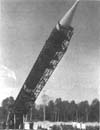







|
|
Last changed 1 May 2001
Given the People's Republic of China's size in terms of geography (third in the world, only slightly behind Canada), population (number one), and economy (second largest in the world by 1999 CIA equivalent purchasing power estimates, with current growth rates in the high single digits), it seems inevitable that China (also called the PRC) will become the dominant power in the world within a few decades. China's leaders are acutely aware of this fact, and are also acutely aware that except for the last few centuries, China has consistently been the most powerful and advanced society in the world for 3500 years. They undoubtedly intend that China will have military capabilities commensurate with this once and future status.
Over the years China has certainly invested a much smaller amount of resources (although not necessarily a much smaller proportion of its resources) to developing and deploying nuclear weapons than either of the two superpowers. The exact size and composition of its nuclear forces is very difficult to determine however due to strict secrecy. Force structure estimates consequently are rather uncertain, and published estimates are even a bit mysterious. It is hard to assess the ultimate source or reliability of the data provided.
Since the cut-off of aid to its nuclear weapons program in 1960 by the Soviet Union, most of the technology used on the program has been developed indigenously. There has been (and continues to be) considerable concern in the West about the export of this technology to non-nuclear powers interested in acquiring these weapons. China is known to have given Pakistan considerable assistance, possibly including actual warhead designs. Recent concern has focused on Chinese deals with Iran. With the collapse of the Soviet Union, China has turned its interest to obtaining more advanced nuclear technology from the successor to its old mentor. Nihon Keizai Shimbun has reported that China bought computer simulation technology for nuclear warheads from Russia during the mid-90s.
To date China has conducted many fewer nuclear tests than the United States or the Soviet Union/Russia (less than 5% as many as either) and this discrepancy accounts for China's initial reluctance to sign on to a permanent ban of all nuclear tests at the CTBT negotiations, although these reservations have now been overcome since the conclusion of China's final test series
The final test series concluded in the spring and summer of 1996. According to Japanese government sources (reported in Nihon Keizai Shimbun), the penultimate underground Chinese nuclear test on 8 June 1996 (calculated at 20 to 80 kilotons) was actually a simultaneous detonation of multiple warheads (a common practice by both the U.S. and USSR). It was said to be part of a program to produce smaller warheads for submarine-launched and multiple-targeted missiles. Overall, the yields since 1990 have suggested that two warheads have been in development: one in the 100-300 kt range, and one in the 600-700 kt range.
China's last nuclear test was detonated at 0149 GMT (9:49 p.m. EDT) on 29 July 1996. According to the Australia Geological Survey Organization in Canberra its yield was 1 to 5 kilotons, with a seismic magnitude of Mb 4.3. This was China's 45th test, and its 22nd underground one.
It is believed that with the conclusion of this series, China has completed development of a range of warheads similar to the state of the art weapons developed by the other major nuclear powers. These would be miniaturized hardened thermonuclear warheads with yields in the tens to hundreds of kilotons, as well as warheads with variable yield options, and enhanced radiation ("neutron bomb") warheads.
The subject of China's neutron bomb capability has been the subject of considerable public attention over the last several years. China reportedly conducted a successful test of a neutron bomb on 29 September 1988; in March 2000 a Chinese military newspaper threatened to use neutron bombs to capture Taiwan if it declared independence. But most of the attention has centered on alleged connections with the theft of nuclear secrets from the United States.
Allegations have circulated for over 20 years that U.S. nuclear weapon technology has been leaked to China. CIA Director George Tenet reported in the 1999 "Intelligence Community Damage Assessment" on Chinese spying, that China "obtained information on a variety of U.S. weapon design concepts and weaponization features, including those of the neutron bomb."
As was reported by Dan Stober in the 13 April 2000 San Jose Mercury News, in 1981 Gwo-Bao Min, a nuclear weapons engineer in the D-Division at the Lawrence Livermore National Laboratory, was forced to resign form the laboratory due to suspicions about having provided China with information about U.S. neutron bomb technology from the W-70 warhead. According to Stober:
Exactly how the government discovered the loss of neutron bomb secrets to China and what led investigators to Min remain a secret.Sources outside the FBI say the agency is protecting its source, which could be a spy or the clandestine interception of an electronic communication.Min continued to be investigated after his resignation by an FBI operation known as "Tiger Trap". Stober interviewed a number of officials familiar with the case:
"We did not design nuclear warheads (in D-Division), but we had access to all that stuff," said one of Min's co-workers. "They're classified documents and you go down and check them out. There's a classified library and you sign your name to show what you checked out."
"If the information was compromised, (the damage) could have been quite severe," said Houston T. Hawkins, an expert on Chinese nuclear weapons who is the top intelligence official at Los Alamos. Hawkins directs the group that wrote the "damage assessment" in the wake of the Tiger Trap case".
Although no prosecution ever developed from Tiger Trap, a December 1982 phone call between Min and Los Alamos scientist Wen Ho Lee emerged as an important piece in the infamous case against Lee two decades later.
Walter Pincus and Vernon Loeb reported in stories published in the Washington Post on 8 April and 9 May 1999 that in 1997 another Chinese-American scientist named Peter H. Lee had been arrested and pled guilty to verbally passing classified nuclear weapons information to Chinese scientists while he was employed as a physicist at Los Alamos. Like Wen Ho Lee (who is unrelated), Peter Lee is a naturalized citizen born in Taiwan. The 1985 incident for which he was convicted involved a briefing Lee gave seven or more top Chinese nuclear scientists for two hours in a small conference room at another Beijing hotel. According to Pincus and Loeb;
"He talked about laser fusion and even discussed problems the United States was having in its nuclear weapons simulation program. He drew diagrams and supplied specifications. He explained test data. And he described at least one portion of a classified paper he had written, knowing that his disclosures violated the law.
"In December 1997 -- more than 12 years after the events, and after a six-year FBI investigation that included agents tapping his phones for months, reading his e-mail and his personal diaries, trailing him to China and conducting a polygraph -- Lee finally confessed and pleaded guilty. He was not paid by the Chinese for information, receiving only some travel expenses in 1997, and there was no evidence he disclosed classified information other than what he, himself, had described".
Ironically even though Peter Lee pled to passing classified defense information to unauthorized recipients (for which he was sentenced in March 1998 to a five-year prison term, suspended in favor of 12 months in a halfway house, a $20,000 fine and 3,000 hours of community service), by the time of his arrest much of the information on laser fusion had been declassified (in 1993). But a DOE impact analysis of Lee's disclosures completed in February 1998 held that the information "was of significant material assistance to the PRC in their nuclear weapons development program, ... This analysis indicates that Dr. Lee's activities have directly enhanced the PRC nuclear weapons program to the detriment of U.S. national security." Lee had also revealed current classified information to Chinese scientists in 1997 about his work at TRW involving space radar imaging of submarines.
By far the most celebrated case of actual and alleged Chinese-American nuclear espionage involved the case against Los Alamos nuclear scientist Wen Ho Lee. This saga grew out of a strange incident in 1995, in which a Chinese intelligence agent walked in to a U.S. diplomatic office unannounced and handed over a collection of highly classified Chinese documents, which included a 1988 Chinese document that made reference to design features of America's miniaturized nuclear warheads. The CIA later concluded that, for unknown reasons, this "walk-in" had acted at the direction of Chinese intelligence.
Of particular interest were some design details of the W-88 warhead, America's most sophisticated design. The details fell far short of evidence that China had obtained anything close to a complete design however, a fact that was often ignored in the later controversy, and it transpired could have been obtained from documents about the warhead distributed at many sites around the country and accessible to thousands of people. Nonetheless, because the warhead design had originated at Los Alamos, an FBI investigation focused there, and because Wen Ho Lee was the only Chinese-American employed in the X-Division, he quickly became the focus of the investigation. Lee's early appearance in Tiger Trap essentially clenched him as the prime (and sole) suspect in the eyes of Department of Energy investigator Notra Trulock.
The Wen Ho Lee investigation was kicked into hyperdrive when the Cox Committee, organized to investigate the transmission of space and missile technology to China, got wind of it and hastily added a sensationalized section on nuclear weapon espionage to the committees final report in December 1998. Virtually no attention was paid to Chinese nuclear spying allegations until a front-page 6 March 1999 New York Times story about the investigation. DOE Secretary Richardson fired Wen Ho Lee two days later. During the next 18 months circumspection was rarely seen in pronouncements made politicians, pundits, and officials. The extravagant claims made about Lee and supposed intelligence compromises led to Lee's arrest, extended imprisonment in solitary confinement, threats of capital punishment, and sworn testimony by government witnesses that was later admitted to be false. In the end the espionage case utterly collapsed with no evidence of spying by Lee ever having been found. Finally a plea agreement was reached on 13 September 2000 in which Lee pleaded guilty to one count of improperly handling classified information and was released.
As far as can be determined from publicly available information, there appears to be no real evidence of China obtaining actual nuclear warhead designs from the U.S. At most the information seems to have been information about warhead design and technology, possibly quite sketchy, that would help guide Chinese research and development down the most productive tracks. Without detailed designs of warheads ("blueprints"), Chinese weapons would necessarily be based on indigenous designs even if they incorporated design features and concepts derived from U.S. systems.
China's nuclear delivery system program's have traditionally proceeded very slowly. This has resulted in the deployment of forces that have been one to two decades behind the other nuclear powers in technology (although cause and effect may be reversed, lack of advanced technology may have been the cause of such tardy deployments). It is believed that fewer than 250 ballistic missiles have ever been deployed (with only the first cryogenic liquid fuel missile having been retired). The vast majority of China's arsenal is not capable of reaching the United States, and thus seems geared towards deterring (or threatening) its immediate neighbors.
|
|
 |
|
| DF-3 Missile | DF-4 Missile | |
Current estimates assert that only about 20 ICBMs are in service - the Dong Feng (East Wind)-5A. This figure is surprising in light of China's ability to produce the same basic booster in larger numbers as the Long March 2 satellite launcher. The U.S. government has stated that in 1981 there were DF-5As deployed in hardened silos at two sites. It is thought to carry the largest warhead ever tested by China (4-5 Mt).
|
|
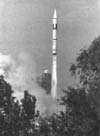 |
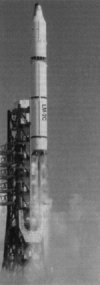 |
| DF-5 Missile | Long March Booster | |
China has placed little emphasis on aircraft as a strategic weapon carrier. The Hong-6 and Qian-5 are short-medium range, light payload aircraft suitable more for tactical or regional-strategic operations. The main bomber, the Hong-6, is based on the Tu-16 Badger which entered Soviet service in 1955 and first flew in China on 27 September 1959. This plane was used to drop two live nuclear weapons in tests: a fission bomb in May 1965 and a megaton-range thermonuclear bomb in June 1967.
The Xian Aircraft Company has been developing the Hong-7 (FB-7), a supersonic fighter-bomber, for over 10 years, but no date has been given for its deployment. The most attractive possibility for modernization of the air arm is simply to purchase advanced fighter bombers from Russia (where they are readily available on easy terms) and modify them to carry Chinese nuclear weapons. China has already purchased 24 Su-27SK and 2 Su-27UBK Flankers (in 1992). Russia has also sold production rights for the Su-27 to China, and an assembly plant has been set up at Shenyang. The first two Chinese-made SU-27s flew in December 1998. China plans to build at least 200 SU-27s over the next 15 years. There is no information available to indicate that they have been assigned a nuclear role however.
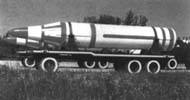 |
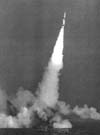 |
|
| Julang-1 Missile | DF-21 (CSS-5) Missile | |
Much less is known about Chinese tactical nuclear weapons, which are believed to comprise a large part of the Chinese nuclear arsenal. The neutron bomb claimed by China is strictly a tactical weapon (designed for use against armored vehicles). China has conducted a number of low yield tests that may have been tactical weapons, and a large military exercise incorporating simulated nuclear weapons was held in June 1982. China's M-family of tactical ballistic missiles, the M-9, M-11 and M-18, are believed to be nuclear capable. Taiwanese officials have said that over the last four years the number of M-family missiles in China's three southern provinces nearby, have increased from 30-50 to 160-200 today. Estimates of Chinese tactical warheads range from 100 to 200, with yields from a few kilotons to hundreds of kilotons.
Chinese Tactical Forces: End of 2000 |
||||||
|---|---|---|---|---|---|---|
Delivery Systems |
Entry into Service |
Range |
Payload |
Accuracy |
Warhead Number and Type |
Launcher Number |
| M-9 | 1988 | 600 | 500 | 300 | Single HE or nuclear | ? |
| M-11 | 1988 | 300 | 500 | < 300 | | ? |
|
| M-18 | 1990s? | Single HE or nuclear | ? | |||
Grand Total |
120 [1] | |||||
Notes | ||||||
| 1. Nuclear armed. | ||||||
Chinese Strategic Forces: End of 2000 |
|||||
|---|---|---|---|---|---|
Weapon Designations |
Launcher Number |
Warhead Loading |
Warhead Number |
Total Yield |
Total Yield [1] |
Land Based Missiles |
|||||
| Dong Feng-3A (DF-3A) CSS-2 (NATO) |
40 | 1 x 2-3.3, or 3 MRV 50-100 kt | 40 | 6-132 | 16.3-88.7 |
| Dong Feng-4 (DF-4) CSS-3 (NATO) |
20 | 1 x 2-3.3 | 20 | 40-66 | 31.7-44.3 |
| Dong Feng-5A (DF-5A) CSS-4 (NATO) |
20 | 1 x 4-5 | 20 | 80-100 | 50.4-58.4 |
| Dong Feng-21A (DF-21A) CSS-5 (NATO) |
48 | 1 x 0.20-0.50 | 48 | 9.6-24 | 16.4-30.2 |
| Dong Feng-31 (DF-31) | 0 | MIRV x ? | 0 | 0 | 0 |
SLBMs/Submarines |
|||||
| Julang (JL)-1 CSS-N-3 (NATO) |
12 | 1 x 0.20-0.50 | 12 | 2.4-6 | 4.1-7.6 |
| Xia Class Submarine | 1 | 12 x JL-1 | |||
Aircraft |
|||||
| Hong-6 (H-6); B-6 (NATO) |
120 | 1-3 x bomb | 120 | kt to Mt (120 [2]) | 120 [2] |
| Qian-5 (Q-5); A-5 (NATO) |
30 | 1 x bomb | 30 | kt to Mt (30 [2]) | 30 [2] |
Grand Total |
288-478 | 269-379 | |||
Notes | |||||
|
1. Equivalent megatonnage (EMT) is based on the relative blast effect and is calculated by Y2/3 where Y is the yield in megatons. 2. Assumes 1 Mt nominal average yield (both gross and EMT). | |||||
Chinese Delivery Systems and Characteristics |
|||||
|---|---|---|---|---|---|
Delivery Systems |
Entry into Service |
Range |
Payload |
Accuracy |
Warhead Number and Type |
Land-Based Missiles |
|||||
| Dong Feng-3A (DF-3A) CSS-2 (NATO) |
1971 | 2800 | 2150 | 1000 | 1 x 2-3.3 Mt, or 3 MRV 50-100 kt |
| Dong Feng-4 (DF-4) CSS-3 (NATO) |
1980 | 4750 | 2200 | 1 x 2-3.3 Mt | |
| Dong Feng-5A (DF-5A) CSS-4 (NATO) |
1981 | 13000 | 3200 | 500 | 1 x 4-5 Mt |
| Dong Feng-21A (DF-21A) CSS-5 (NATO) |
1985 | 1800 | 600 | 1 x 0.20-0.50 Mt | |
| Dong Feng-31 (DF-31) | 2001? | 8000 | MIRV x ? | ||
| New ICBM | 2010? | 12-13000 | MIRV x ? | ||
SLBMs/Submarines |
|||||
| Julang (JL)-1 CSS-N-3 (NATO) |
1987 | 1700 | 600 | 1 x 0.20-0.50 Mt | |
| Xia Class Submarine | 1987 | 12 x JL-1 | |||
| Julang (JL)-2 CSS-NX-4 (NATO) |
2010? | 8000 | 600 | 1 x 0.20-0.50 Mt | |
Aircraft |
|||||
| Hong-6 (H-6); B-6 (NATO) |
1965 | 3100 | 4500 | 1-3 x bomb (kt to Mt) | |
| Qian-5 (Q-5); A-5 (NATO) |
1970 | 400 | 1500 | 1 x bomb (kt to Mt) | |
| Notes | |||||
Principal sources for the section on China are: